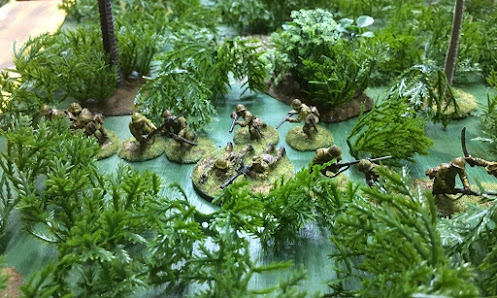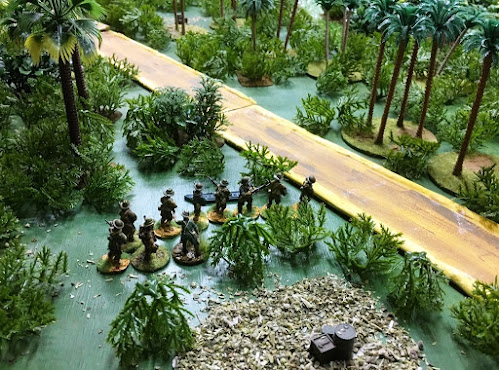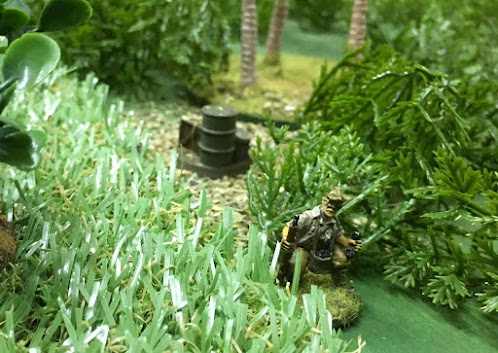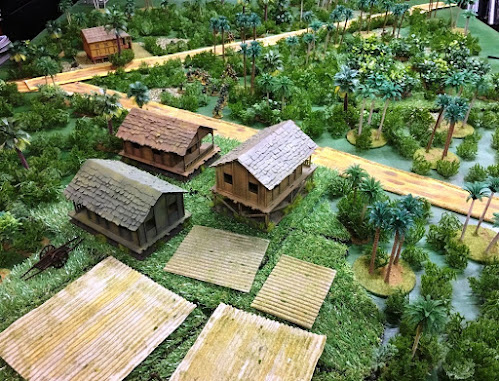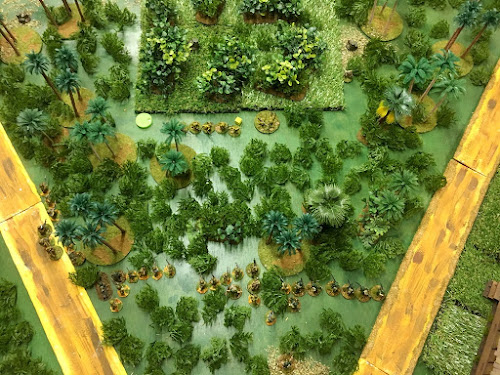The Australians had inflicted a reverse on the Japanese, pushing them back from the vital road junction near Yong Peng. Wary of pushing too far north without safe flanks, the Australian platoon of Young Lt. Kenneth Reid halted to prepare for the inevitable Japanese counter-attack.
This was the eighth battle in the enjoyable Malaya 1942 campaign using the Chain of Command rules by TooFatLardies. Leith was looking to reverse the fortunes of the Japanese, while I was hoping the Australians could hold off the Japanese again.
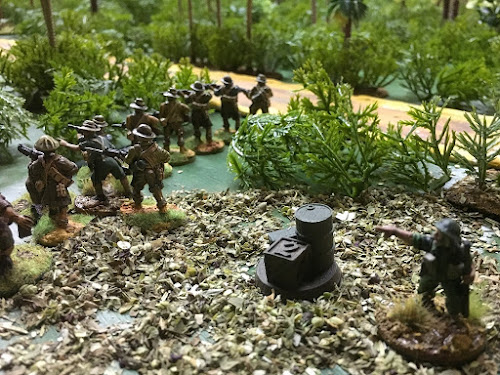 |
| Sgt. Turner directs the Australian 1st and 4th sections |
JAPANESE 6th PLATOON
Yet another new Japanese platoon was committed to battle; the sixth one for the campaign so far.
- Rikugun Yukimura led the 6th platoon in the counter-attack. He was a 29-year-old who had been fighting in China for many years.
- Gunsō Aikawa assisted him, 28-year-old cart driver from Yokohama.
- Rifle squad 1 was led by 24-year-old Gocho Naka, the fourth son of a poor family.
- Rifle squad 2 was led by Gocho Minami, a 25-year-old who left religious studies to join the army in support of the Emperor.
- Rifle squad 3 was led by the 22-year-old Gocho Sannai.
- The grenade discharger squad was led by the tall Gocho Noguchi.
AUSTRALIAN 1st PLATOON
Lieutenant Kenneth Reid’s platoon had delayed the Japanese vanguard. They had temporarily halted the Japanese in a few of the battles and now looked to push them back further from Singapore with a limited counter-attack.
The Australians had to carry the one platoon through the campaign. But with some replacements at the start of battle 6 and two recent wins, the Australians were only 1 man short. At the beginning we had not expected the Australians to have almost a full platoon so far into the campaign. A few more losses for the Australians would have seen their numbers dwindle rapidly.
- The CO’s opinion of Lt. Reid was +6. He was becoming a little arrogant. The men's opinion was good at +6, given his frequent successes.
- Sergeant Gary Turner ably assisted him.
- Corporal Brian Evans led the 1st section.
- Corporal Colin Moore led the 2nd section.
- Corporal William Colling led the 3rd section.
- Private Joseph Pentram returned from the aid station to leave the platoon only 1 man short.
MAP
For the fourth time in the campaign we were fighting on map 2. The Japanese had returned to the attack using scenario 2 from the main rule book.
SUPPORT
Leith rolled 5 points of support for the Japanese. With half of this (rounded down), +3 force difference between platoons, and +2 from the CO’s opinion, the Australians had 7 support points.
With the recent poor showing of the Japanese armour, the Australians anticipated an infantry counter-attack. They decided on an extra infantry section and the return of the Lanchester armoured car.
The Japanese chose a Type 92 7.7mm MMG team and a Type 92 70mm infantry gun for additional fire support. Due to their preparedness in the real campaign, some of their support choices are quite low cost.
Again, we kept these choices hidden from each other.
FORCE MORALE
The Japanese had a +1 adjustment to the die roll due to the campaign. The Australians had +2 due to campaign opinions. The result was the Australians starting with 10 and the Japanese with 9.
PATROL PHASE
To win this scenario the Japanese only have to get a unit off the Australian baseline or force the Australians to withdraw. To push their jump-off points as far forward as possible, Leith chose to use 3, rather than 4, patrol markers.
His roll to get 4 extra moves at the start helped with this. The Australians moved up a little and began moving around the Japanese left flank. Seeing this, the Japanese pushed forward to end the Patrol phase quickly before the Australians outflanked them.
The white circles show the position of the Japanese jump-off points and the blue circles the Australian.
BATTLE
The Australians had the first phase due to their higher Force Morale.
Turn 1 Phase 1
- A command roll of 2, 3, 4, 5, 6 allowed the Australians to deploy their 1st and 4th sections west of the road. Sergeant Turner arrived to organise them on overwatch.
 |
| Australians arrive and immediately go on overwatch |
- The Japanese responded with 1, 3, 3, 4, 5. Their 2nd rifle squad deployed just behind the jump-off point west of the road to avoid overwatch fire.
- Their 1st squad arrived just east of the road. Firing across the road allowed them to concentrate shots onto the Australian 4th rifle team for 2 kills and 1 shock. A nasty start.
Turn 1 Phase 2
- The Australians responded with a double phase. Command of 1, 2, 3, 6, 6 allowed return fire, which wounded Gocho Naka of the 1st rifle squad (-1 command point but no force morale effect).
- The 1st section moved forward but found the going slow through the jungle.
- The Australian 2nd section arrived to oppose the Japanese 1st squad, inflicting 4 shock.
Turn 1 Phase 3
- Continuing with 1, 2, 2, 5, 6 the Australians followed up with 3 kills on the Japanese 1st squad. Quite a bloodthirsty battle already.
- A command roll of 2, 2, 3, 3, 4 allowed the Japanese to bring in the 70mm infantry gun, although their opening salvo missed their enemy.
- The 2nd rifle squad moved forward but failed to hurt the Australian 4th rifle team, although the newly arrive MMG inflicted 1 kill. This was added to by the 1st rifle squad killing a Bren loader and adding 2 shock to the rifle team in the Australian 2nd section.
- The 3rd Japanese squad arrived but were not in a position to fire. Leith was taking no chances after his difficulty in deploying last time. The Japanese were arriving thick and fast.
Turn 1 Phase 4
- The Lanchester arrived. Seeing only the MMG allowed the turret machine guns to inflict 1 kill and 1 shock on them. Targeted fire from the 4th section Bren added another shock.
- Using more of the 1, 2, 3, 4, 5 gave 2 shock to the infantry gun and 1 shock to the 1st rifle squad.
- The arrival of Corporal Colling’s 3rd Australian section, near the SW corner of the village, added more shots onto the Japanese 1st rifle squad, but for no effect.
 |
| The supporting Lanchester armoured car arrives |
- The Japanese rolled a 1, 1, 1, 2, 3 which allowed them to respond aggressively. The infantry gun killed a 1st section rifleman. The MMG, aided by the Japanese 2nd rifle squad, swept the ranks of the 4th section with fire. 1 rifleman went down. 3 shock were added to the rifle team and 1 shock to the Bren team. The concentrated fire on the 4th section was taking its toll.
- Worried about the whole Japanese line being outflanked, Gocho Sannai immediately launched an attack. Moving quickly through the primary jungle, the Japanese were almost upon the Australians before they had time to respond. The ensuing melee between the aggressive Japanese and the stubborn Australians was a tough and bloody affair. No quarter was given by either side.
 |
| The Japanese 3rd squad infiltrating towards the Australian 3rd section |
- For the Japanese attackers: 13 dice from 13 men, +2 dice from Gocho Sannai, +4 dice for being aggressive (1 per 3 men) +2 dice for the Japanese LMG counting as an SMG in attack (see the Japan Island Defence platoon list for details) result in a total of 21 dice.
- For the Australians: 8 dice from 8 men (this is the section that was 1 man short in the campaign), +2 dice from Corporal Colling, +2 dice from the Japanese using 2D6 to move into range, +2 dice from the Thompson SMG, +4 dice for the Bren gave 18 dice so far. Adding 1 dice per 2 for defending heavy cover resulted in a total of 27 dice.
 |
| A close fought melee as the Australians fight off the surprise attack of the Japanese |
- Both leaders were wounded, losing a command point each, but neither affecting Force Morale.
- 7 Australians lay dead amongst 10 Japanese. The stubborn Australians received no shock, but the Japanese gained 5. They did not like fighting these strapping sons of convicts.
 |
| Despite only having 2 men left, the stubborn Australians see off the 4 surviving Japanese |
- The wounded Gocho Sannai broke with his 3 remaining men (fleeing 18” in disorder) but satisfied that Corporal Colling with just the Bren gunner were not going to cause any more problems. At great cost he had stopped the Japanese line being outflanked and inflicted severe casualties on the Australians.
- Amazingly, neither side lost any force morale from the other rolls (rifle team wiped out for the Australians and squad breaking for the Japanese). Although the Japanese had to call upon the -1 dice roll adjustment which this campaign gives them when rolling on the “Bad Things Happen” table.
 |
| Corporal Colling and a Bren gunner are all that is left of the Australian 3rd section |
Turn 1 Phase 5
- Lt. Reid was concerned with the high rate of casualties but feeling arrogant he decided to continue. A command of 1, 4, 5, 5, 6 was not great. The Lanchester could not activate and a chain of command die was close but not quite there.
- The Australian shooting was handy, but not enough to fully discomfort any of the Japanese squads or supports. Casualties continued to mount as they had for both sides so far (1 shock on the MMG, 1 kill on 1st squad, 1 kill and 1 shock on 2nd squad).
- Could the Japanese make the Australians pay for not withdrawing early enough?
- Their command roll of 3, 4, 4, 4, 6 brought on the mortars within direct line of sight of the remnants of the Australian 3rd section. They failed to finish off the duo, adding just 1 shock.
- Fire from the infantry gun inflicted 1 shock on the Bren team from the 1st section.
- The MMG continued to be effective, with a shock on the 4th section rifle team plus a kill and a shock on their Bren team. The 4th section was now pinned.
- Meanwhile, 2 shock were added to the 2nd section’s rifle team.
Turn 1 Phase 6
- Feeling a little lucky after that last phase of the battle, sense returned to Lt. Reid so he decided to withdraw. Although taking a lot of casualties, at least he had again inflicted more on the Japanese.
WRAP UP
Despite ending as a major victory to the Japanese, it was a very close battle. Mounting casualties from the start, even without the close combat. Casualties from fire and close combat in the end totalled 16 for the Japanese and 14 for the Australians. Slightly better command rolls for the Australians and Japanese in the last two phases may have seen an even higher casualty rate.
Interesting that neither side lost any force morale points, despite quite a few rolls. The jungle must have made it difficult to see far, because neither side were concerned when their leaders were injured. The -1 adjustment the Japanese get in this campaign certainly helped them with their “Bad Things Happen” rolls.
 |
| The victorious Japanese continue southward |
CAMPAIGN IMPACT
The first major victory of the campaign to the Japanese. The Australian counter-attack had run out of steam and they had been again pushed back to defend Latipah’s tea house, near the important road junction, in the next battle.
Due to the higher force morale of the Australians and the keenness of the Japanese to push on, they were unable to recover any additional men from the battlefield. They had to leave that task for following troops.
The Japanese platoon of Rikugun Yukimura would continue the attack next battle. One of the casualties was from the supporting MMG team, so his platoon would be 11 short, including the 4 missing the next battle. All the Japanese leaders continue to fight as none took 2 or more wounds.
With 5 losses being from the supporting 4th section, the Australians would be a total of 8 short (1 previous loss, 4 dead from this battle and 3 missing the next fight).
Looks likely that both sides would be a section/squad short.
Pleased by the victory, the Japanese CO’s opinion of Rikugun Yukimara rose to +2 but the men’s opinion dropped to -2 due to the butcher’s bill. His own outlook remained cheerful.
The CO’s opinion of Lt. Kenneth Reid dropped to +5, but the men’s opinion actually rose to +7. They felt they had acquitted themselves well and no longer believed in the invincibility of the Japanese. Lt. Reid was chastened by the hard fight, losing his arrogance and once again becoming heroic.
How close to Singapore could the Japanese get in the next two battles?


